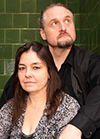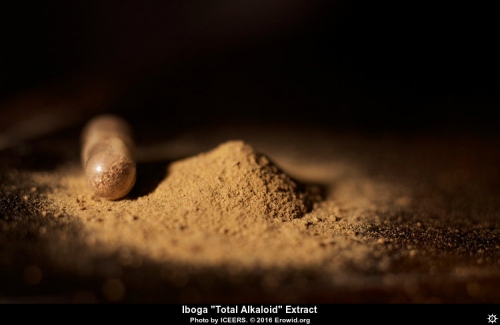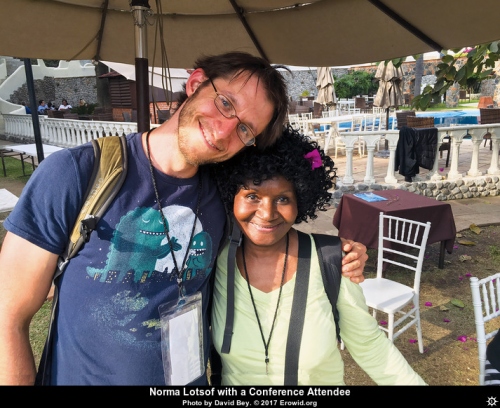2016 Global Ibogaine Conference
Aug 2016
Citation: Bey, D. "2016 Global Ibogaine Conference". Erowid Extracts. Aug 2016;29:22-23. Online edition: Erowid.org/general/conferences/conference_2016_ibogaine.shtml
On March 14-16, 2016, experts, activists, and enthusiasts interested in the African plant medicine ibogaine gathered in the town of Tepoztlan, Mexico, to attend the 5th Global Ibogaine Conference. They came to share, lecture, discuss, bicker about, and celebrate the miraculous effects of Tabernanthe iboga on the nervous system of mammals--especially those mammals happening to be addicted to opiates or other drugs.
Iboga is used as a sacrament in Gabon by members of the Bwiti religion, who reputedly learned of its use from rainforest Pygmies. Everyone present at the conference, however, was ultimately there because of Howard Lotsof, who in 1962, as a young man, accidentally discovered that after taking ibogaine he was no longer addicted to heroin. Lotsof spent the rest of his life pioneering the use of ibogaine to treat addiction and organizing an international community dedicated to this goal. The first Global Ibogaine Conference, in 2007, was held in his honor. He passed away in 2010, survived by his radiant wife Norma Lotsof.
The previous Global Ibogaine Conference, held two years ago in Durban, South Africa, boasted about thirty participants. This year it attracted over 250 attendees, and was quite possibly the largest conference dedicated to ibogaine that has ever taken place. There is no way to easily capture the enormous experience of attending this event.
One prominent theme among attendees and presenters was the contrast between medical model ibogaine clinics, with MDs and RNs on staff, and the lay-provider model, where detoxes are facilitated mostly by former addicts. The split between the medical/academic folks and the heroin-user/lay-provider contingent was evident, though generally cordial, throughout the conference.
Of the panels I attended, one of the most interesting was "Perspectives On Plant Intelligence" by Ken Alper, Dennis McKenna, Luis Eduardo Luna, and Dimitri Mugianis. McKenna expounded on the intense density of information occurring at the molecular level in the signal transduction networks of the plant kingdom. Alper delivered a brilliant presentation on plant decision-making processes (such as how climbing vines figure out the best way to grow) and the effect of iboga on human learning and freedom of choice. Luna provided a scholarly perspective on plant intelligence and personhood, contrasting the lack of reverence for botanical wisdom long held by scientific authorities with the animistic traditions of indigenous shamanism.
Finally, Dimitri Mugianis gave a blisteringly charismatic talk on the "character" of iboga as he sees it, looking at those this plant spirit draws to its bosom. Dimitri's point was that while other plant spirits (say, ayahuasca) seem to attract doctors, lawyers, and tech-folk (his assertion), by contrast iboga seems to manifest a distinct preference for the down-and-out and the oppressed--from drug addicts in NYC to the Gabonese freedom-fighters taking shelter with the Pygmies while fighting for independence from the French.
Among the pressing issues brought up was the terrible peril the iboga plant itself is in. As worldwide interest in the medicine grows, demand has skyrocketed, leading to intense poaching. In the words of one of the conference panelists "We are in danger of loving it to death".
This was addressed in one of the most controversial panels, "Ethnobotany of Ibogaine & Alternative Production Methods". Presenter Chris Jenks (famous for creating the first practical, non-toxic ibogaine alkaloid extraction process, which reduced the price of ibogaine and helped expand the ibogaine-assisted medical detox movement) talked about the synthesis pathway he worked out to produce ibogaine from Voacanga africana (not endangered!). McKenna and Eduardo Jovel discussed the work they are doing up at the University of British Colombia using transgenic techniques to make "hairy-root" cultures of T. iboga, which, if perfected, could provide an alternate source for iboga, rather than sourcing it directly from the wild.
Sitting on the same panel was Yann Guignon, a French resident of Gabon who excoriated everyone in the room who had ever taken iboga without knowing the Bwiti-given name of the specific plant whose bark their medicine came from. In Guignon's view, the ibogaine community, having depleted iboga in the wild, is turning its back on Gabon. He believes that the first duty of anyone who has benefited from iboga is to give back, directly, to Gabon and the Gabonese people.
Once Guignon threw down the gauntlet, things got pretty tense and post-colonial fairly quickly. By the end of the Q&A, wherein Guignon pointed the damning finger of biopiracy directly at McKenna and Jovel, poor Dr. Jovel stood there with tears in his eyes, passionately asserting his commitment to the preservation of the plant. Speaking as an indigenous El Salvadorian who had known violence and exile, and as one who regularly participates not only in the conventional "scientific" paradigm but also quite seriously in indigenous practices, Dr. Jovel was not quite sure how he fit into the narrative of an evil corporate scientist out to screw over the earth for a buck.
Like most conferences on psychedelics, this one drew attendees idiosyncratic gathering of people it represented. By the end, most felt the program had fulfilled its promise that "The conversations that will take place here will shape the future of ibogaine therapy and research internationally."
For many participants it resembled nothing less than an enormous family reunion--albeit of one of the strangest families ever united by a common tree (or in this case, shrub). The event closed with a bangin' party, in which distinguished faculty from the NYU School of Medicine threw down on the dance floor, shoulder to shoulder with former addicts turned initiated medicine-men (which seemed to sum up the whole experience for me). The party raged until the power abruptly went out, at which point people gathered around a fire. Those who had been to Gabon brought out traditional Bwiti instruments and taught iboga songs to those who had not.
The next morning folks dispersed back out into the world at large, melting into the anonymous crowds at Mexico City airport, where no one had the faintest idea what we'd been up to and they wouldn't believe us if we told them.
Iboga is used as a sacrament in Gabon by members of the Bwiti religion, who reputedly learned of its use from rainforest Pygmies. Everyone present at the conference, however, was ultimately there because of Howard Lotsof, who in 1962, as a young man, accidentally discovered that after taking ibogaine he was no longer addicted to heroin. Lotsof spent the rest of his life pioneering the use of ibogaine to treat addiction and organizing an international community dedicated to this goal. The first Global Ibogaine Conference, in 2007, was held in his honor. He passed away in 2010, survived by his radiant wife Norma Lotsof.
The previous Global Ibogaine Conference, held two years ago in Durban, South Africa, boasted about thirty participants. This year it attracted over 250 attendees, and was quite possibly the largest conference dedicated to ibogaine that has ever taken place. There is no way to easily capture the enormous experience of attending this event.
One prominent theme among attendees and presenters was the contrast between medical model ibogaine clinics, with MDs and RNs on staff, and the lay-provider model, where detoxes are facilitated mostly by former addicts. The split between the medical/academic folks and the heroin-user/lay-provider contingent was evident, though generally cordial, throughout the conference.
There is no way to easily capture the enormous experience of attending this event.
Finally, Dimitri Mugianis gave a blisteringly charismatic talk on the "character" of iboga as he sees it, looking at those this plant spirit draws to its bosom. Dimitri's point was that while other plant spirits (say, ayahuasca) seem to attract doctors, lawyers, and tech-folk (his assertion), by contrast iboga seems to manifest a distinct preference for the down-and-out and the oppressed--from drug addicts in NYC to the Gabonese freedom-fighters taking shelter with the Pygmies while fighting for independence from the French.
Among the pressing issues brought up was the terrible peril the iboga plant itself is in. As worldwide interest in the medicine grows, demand has skyrocketed, leading to intense poaching. In the words of one of the conference panelists "We are in danger of loving it to death".
This was addressed in one of the most controversial panels, "Ethnobotany of Ibogaine & Alternative Production Methods". Presenter Chris Jenks (famous for creating the first practical, non-toxic ibogaine alkaloid extraction process, which reduced the price of ibogaine and helped expand the ibogaine-assisted medical detox movement) talked about the synthesis pathway he worked out to produce ibogaine from Voacanga africana (not endangered!). McKenna and Eduardo Jovel discussed the work they are doing up at the University of British Colombia using transgenic techniques to make "hairy-root" cultures of T. iboga, which, if perfected, could provide an alternate source for iboga, rather than sourcing it directly from the wild.
Sitting on the same panel was Yann Guignon, a French resident of Gabon who excoriated everyone in the room who had ever taken iboga without knowing the Bwiti-given name of the specific plant whose bark their medicine came from. In Guignon's view, the ibogaine community, having depleted iboga in the wild, is turning its back on Gabon. He believes that the first duty of anyone who has benefited from iboga is to give back, directly, to Gabon and the Gabonese people.
Difficult issues were brought up, and more than a few panels had people practically in tears.
Like most conferences on psychedelics, this one drew attendees idiosyncratic gathering of people it represented. By the end, most felt the program had fulfilled its promise that "The conversations that will take place here will shape the future of ibogaine therapy and research internationally."
For many participants it resembled nothing less than an enormous family reunion--albeit of one of the strangest families ever united by a common tree (or in this case, shrub). The event closed with a bangin' party, in which distinguished faculty from the NYU School of Medicine threw down on the dance floor, shoulder to shoulder with former addicts turned initiated medicine-men (which seemed to sum up the whole experience for me). The party raged until the power abruptly went out, at which point people gathered around a fire. Those who had been to Gabon brought out traditional Bwiti instruments and taught iboga songs to those who had not.
The next morning folks dispersed back out into the world at large, melting into the anonymous crowds at Mexico City airport, where no one had the faintest idea what we'd been up to and they wouldn't believe us if we told them.




